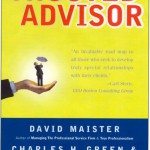Let Your Doing Do Your Talking: Five High Impact Tips
 It seems only natural. We rehearse, over and over, what we say and how we say it. “Put the em-pha-sis on the right syl-la-ble.” “Po-ta-to, po-tah-to.” “Take my wife—[wait for it…] please.” And so on.
It seems only natural. We rehearse, over and over, what we say and how we say it. “Put the em-pha-sis on the right syl-la-ble.” “Po-ta-to, po-tah-to.” “Take my wife—[wait for it…] please.” And so on.
What you say and how you say it is indeed critical—especially if you’re a stand-up comic or a keynote speaker.
But when it comes to sales and client relationships—what drives impact is not your saying—it’s your doing. You sell by doing, not by telling.
Behaving Trumps Talking
How often have you heard:
– Actions speak louder than words
– What you do speaks so loud that I cannot hear what you say
– People will judge you by your actions, not your intentions
-Walk the talk
-Talk is cheap because supply exceeds demand
-You have two ears and one mouth for a reason
There is much wisdom in folk wisdom like this. We over-emphasize content, over-analyze our words. Worse–our actions can contradict our words. If part of your spiel is that you’re client-focused—in that moment, you’re not.
It’s your actions that will sell—or not.
Five Opportunities to Replace Talking with Actions
You can read elsewhere tips about your demeanor, look, body language. Here are five ways you can design your actions to help your customers experience what you’re about.
1. When you illustrate a point through an example–make the example about this client, not your other clients. Everyone’s favorite subject is—themselves. Indulge them.
2. Offer free samples. It works with ice cream, but ice cream has color, taste, texture. Tax advice doesn’t. It becomes tangible only when the client gets some. Give some samples.
3. Work side by side with your customer. Don’t waste time back at your office pondering what your customer might want—ask them.
4. Put potential clients in touch with past clients–let them talk directly. They each learn a lot, and you get the credit for the introduction.
5. Ask for advice, not feedback. You can replace a hundred customer-sat written surveys with one serious, face-to-face meeting asking your customer to help you redesign your processes.
And one final bonus tip: Don’t say ‘trust me.’ Let your trustworthy actions do your talking for you.




Those are all really good pointers Charles.
I always said to sales people that if they treated their customers like a troubled best friend, they wouldn’t go far wrong. Talk to a best friend about their worrying business issues and you’ll find yourself natuarally going down your list. You’ll work through the issues side by side, offer some free advice until it becomes hours of effort and real work, you’ll do a lot of asking, listening and testing of ideas. And most of the action will take place at the resturant, pub, or back at your friend’s place of work.
In my opinion the best working relationships are built during action on a project; not out on the golf course, or a heavy drinking session together at a conference. If you can take a big issue off the intray of a client and start working on it without charge you’ll develop a better relationhip than spending the same 4 hours on the golf course together. (And if you don’t know them well, it’s very unlikely they’ll accept your invitation to play golf.)
You’ve hit all the buttons for how a trusting relationship feels when it’s in action.
Chris,
Underscore your idea of “troubled best friend.” I’ve heard “treat your customer like a friend” before, and there’s a lot to like about it, though it can be a little facile. But–treat your customer like a troubled best friend–that’s really interesting. As you say, thinking of it that way naturally runs one down the list; and it’s a very good mindset for anyone attempting to actually help a customer (what a concept).
Thank you for that very cool idea; may I steal it (with attribution of course!)
Steal away! No patent on ideas.
‘Troubled best friend’ and the ‘pub talk’ dovetail together nicely. The ‘pub talk’ exercise is about meeting with no laptop, no note-book, no paper, no recorder, no brief case – just ask and listen – then go away to work on some ideas later. Coming up with ideas instantly belittles the problems and the fact that your’friend’ hasn’t come up with the answers after a lot of thought. There needs to be more ‘Venus’ than ‘Mars’ at the first early stage.
‘There needs to be more ‘Venus’ than ‘Mars’ at the first early stage.’
Chris, stop. You have exceeded your quota of exceedingly quotable quips per post.
Seriously, I love that one.
Chris,
Underscore your idea of “troubled best friend.” I’ve heard “treat your customer like a friend” before, and there’s a lot to like about it, though it can be a little facile. But–treat your customer like a troubled best friend–that’s really interesting. As you say, thinking of it that way naturally runs one down the list; and it’s a very good mindset for anyone attempting to actually help a customer (what a concept).
Thank you for that very cool idea; may I steal it (with attribution of course!)
‘There needs to be more ‘Venus’ than ‘Mars’ at the first early stage.’
Chris, stop. You have exceeded your quota of exceedingly quotable quips per post.
Seriously, I love that one.
Steal away! No patent on ideas.
‘Troubled best friend’ and the ‘pub talk’ dovetail together nicely. The ‘pub talk’ exercise is about meeting with no laptop, no note-book, no paper, no recorder, no brief case – just ask and listen – then go away to work on some ideas later. Coming up with ideas instantly belittles the problems and the fact that your’friend’ hasn’t come up with the answers after a lot of thought. There needs to be more ‘Venus’ than ‘Mars’ at the first early stage.
Those are all really good pointers Charles.
I always said to sales people that if they treated their customers like a troubled best friend, they wouldn’t go far wrong. Talk to a best friend about their worrying business issues and you’ll find yourself natuarally going down your list. You’ll work through the issues side by side, offer some free advice until it becomes hours of effort and real work, you’ll do a lot of asking, listening and testing of ideas. And most of the action will take place at the resturant, pub, or back at your friend’s place of work.
In my opinion the best working relationships are built during action on a project; not out on the golf course, or a heavy drinking session together at a conference. If you can take a big issue off the intray of a client and start working on it without charge you’ll develop a better relationhip than spending the same 4 hours on the golf course together. (And if you don’t know them well, it’s very unlikely they’ll accept your invitation to play golf.)
You’ve hit all the buttons for how a trusting relationship feels when it’s in action.